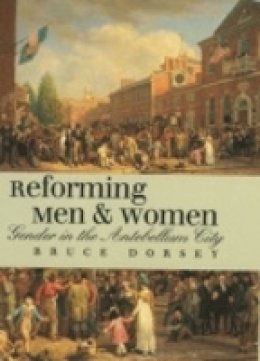
Reforming Men and Women: Gender in the Antebellum City
Bruce Dorsey
Before the Civil War, the public lives of American men and women intersected most frequently in the arena of religious activism. Bruce Dorsey broadens the field of gender studies, incorporating an analysis of masculinity into the history of early American religion and reform. His is a holistic account that reveals the contested meanings of manhood and womanhood among antebellum Americans, both black and white, middle class and working class.Urban poverty, drink, slavery, and Irish Catholic immigration—for each of these social problems that engrossed Northern reformers, Dorsey examines the often competing views held by male and female activists and shows how their perspectives were further complicated by differences in class, race, and generation. His primary focus is Philadelphia, birthplace of nearly every kind of benevolent and reform society and emblematic of changes occurring throughout the North. With an especially rich history of African-American activism, the city is ideal for Dorsey's exploration of race and reform.Combining stories of both ordinary individuals and major reformers with an insightful analysis of contemporary songs, plays, fiction, and polemics, Dorsey exposes the ways race, class, and ethnicity influenced the meanings of manhood and womanhood in nineteenth-century America. By linking his gendered history of religious activism with the transformations characterizing antebellum society, he contributes to a larger quest: to engender all of American history.
Product Details
About Bruce Dorsey
Reviews for Reforming Men and Women: Gender in the Antebellum City
Peter C. Baldwin (, University of Connecticut)
Common-Place: The Interactive Journal of Early American Life
At the heart of the book are examinations of four topics: poverty, drink, slavery, and immigration. In each chapter, Dorsey begins by identifying the gendered ideologies of male and female reform groups, and then shows how their reform activities interacted with different racial and class positions.... Because of the novelty of fully developed 'holistic' gender analysis (Dorsey's term) and his even-handed treatment of race and class as well as gender, the book is full of surprises. Familiar relationships between well-known episodes in reform shift, and new perspectives emerge.
Susan Armitage, Washington State University
Journal of Interdisciplinary History
What Dorsey has attempted here, and essentially accomplished, is nothing less than a history of gender in antebellum urban America through the lens of reform. It is also the most thorough and convincing account of the development of male gender ideology in the early republic yet published. The publication of Reforming Men and Women marks an important advance in the historiography of American gender history.... The arguments here are complex, subtle, and ultimately convincing.... To top it all off, Dorsey weaves close readings of popular fiction into each chapter. The result is to present the reader with a variety of different kinds of evidence and to show how the theoretical observations of literary scholars can be used to buttress traditional historical arguments. What makes all this work so well is Dorsey's fine prose.
Amy S. Greenberg, The Pennsylvania State University
Journal of the Early Republic 22:4
